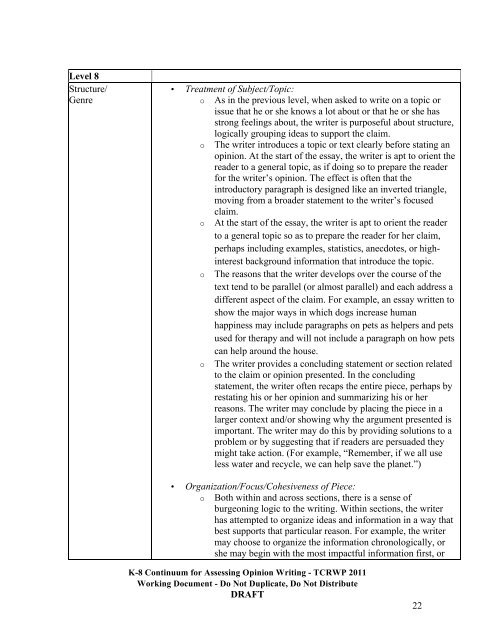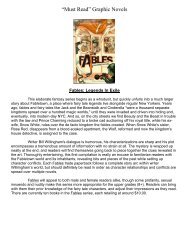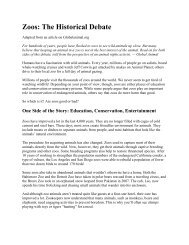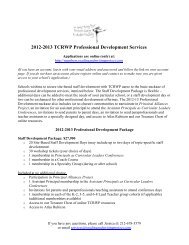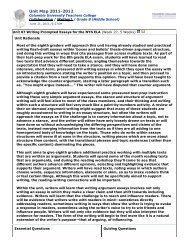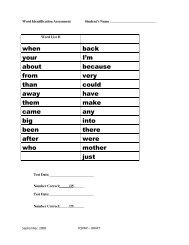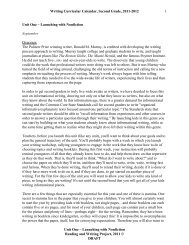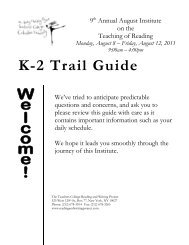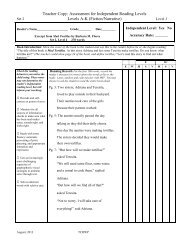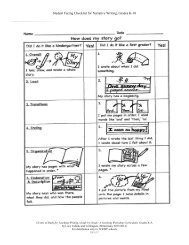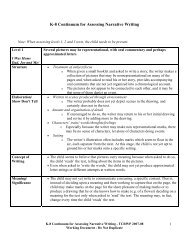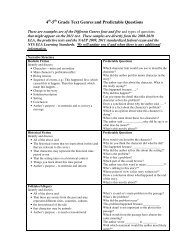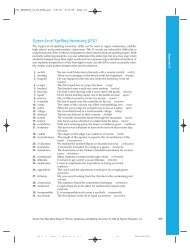Continuum for Assessing Opinion/Argument Writing - The Reading ...
Continuum for Assessing Opinion/Argument Writing - The Reading ...
Continuum for Assessing Opinion/Argument Writing - The Reading ...
Create successful ePaper yourself
Turn your PDF publications into a flip-book with our unique Google optimized e-Paper software.
Level 8<br />
Structure/<br />
Genre<br />
• Treatment of Subject/Topic:<br />
o As in the previous level, when asked to write on a topic or<br />
issue that he or she knows a lot about or that he or she has<br />
strong feelings about, the writer is purposeful about structure,<br />
logically grouping ideas to support the claim.<br />
o <strong>The</strong> writer introduces a topic or text clearly be<strong>for</strong>e stating an<br />
opinion. At the start of the essay, the writer is apt to orient the<br />
reader to a general topic, as if doing so to prepare the reader<br />
<strong>for</strong> the writer’s opinion. <strong>The</strong> effect is often that the<br />
introductory paragraph is designed like an inverted triangle,<br />
moving from a broader statement to the writer’s focused<br />
claim.<br />
o At the start of the essay, the writer is apt to orient the reader<br />
to a general topic so as to prepare the reader <strong>for</strong> her claim,<br />
perhaps including examples, statistics, anecdotes, or highinterest<br />
background in<strong>for</strong>mation that introduce the topic.<br />
o <strong>The</strong> reasons that the writer develops over the course of the<br />
text tend to be parallel (or almost parallel) and each address a<br />
different aspect of the claim. For example, an essay written to<br />
show the major ways in which dogs increase human<br />
happiness may include paragraphs on pets as helpers and pets<br />
used <strong>for</strong> therapy and will not include a paragraph on how pets<br />
can help around the house.<br />
o <strong>The</strong> writer provides a concluding statement or section related<br />
to the claim or opinion presented. In the concluding<br />
statement, the writer often recaps the entire piece, perhaps by<br />
restating his or her opinion and summarizing his or her<br />
reasons. <strong>The</strong> writer may conclude by placing the piece in a<br />
larger context and/or showing why the argument presented is<br />
important. <strong>The</strong> writer may do this by providing solutions to a<br />
problem or by suggesting that if readers are persuaded they<br />
might take action. (For example, “Remember, if we all use<br />
less water and recycle, we can help save the planet.”)<br />
• Organization/Focus/Cohesiveness of Piece:<br />
o Both within and across sections, there is a sense of<br />
burgeoning logic to the writing. Within sections, the writer<br />
has attempted to organize ideas and in<strong>for</strong>mation in a way that<br />
best supports that particular reason. For example, the writer<br />
may choose to organize the in<strong>for</strong>mation chronologically, or<br />
she may begin with the most impactful in<strong>for</strong>mation first, or<br />
K-8 <strong>Continuum</strong> <strong>for</strong> <strong>Assessing</strong> <strong>Opinion</strong> <strong>Writing</strong> - TCRWP 2011<br />
Working Document - Do Not Duplicate, Do Not Distribute<br />
DRAFT<br />
22


